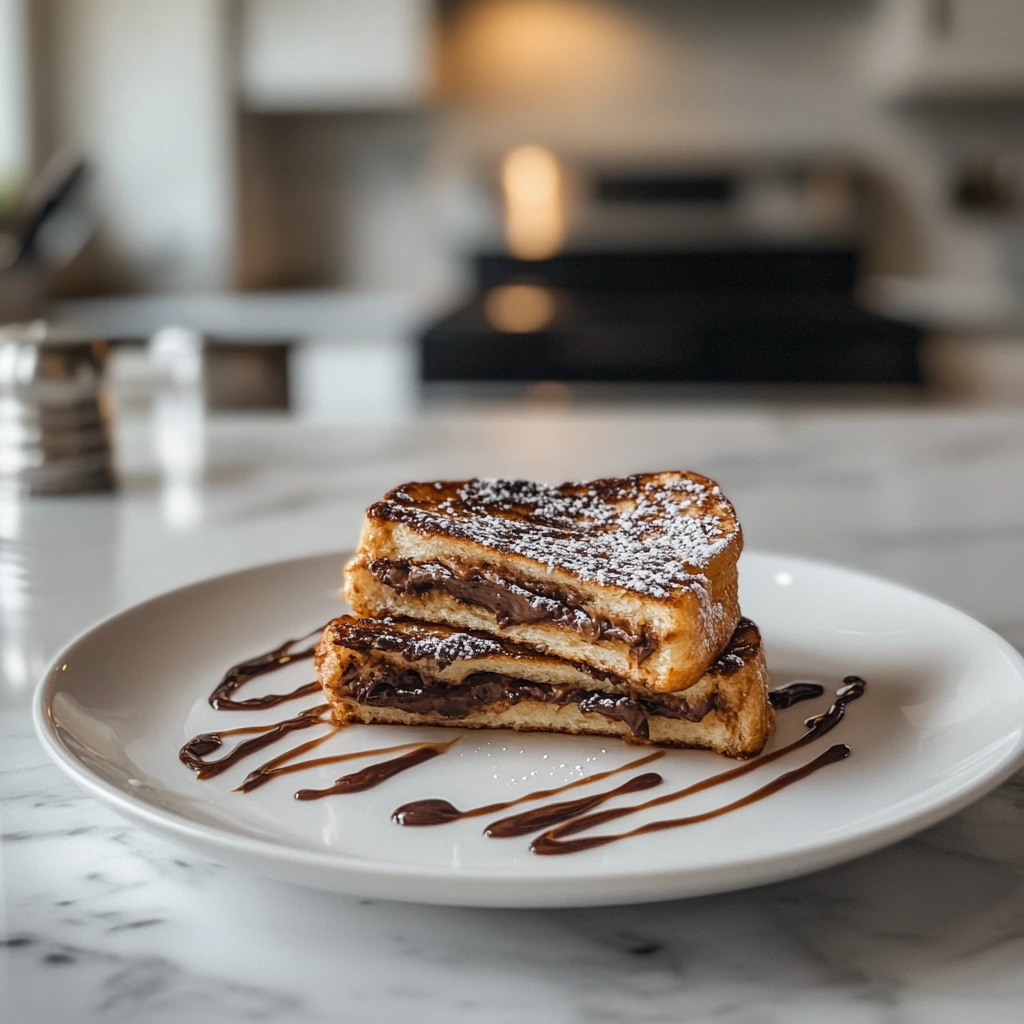Elevate your breakfast experience with our ultimate stuffed french toast recipe. This guide not only provides a detailed, step-by-step walkthrough for preparing a decadent dish but also inspires you to explore creative twists and techniques that elevate your morning routine.
Whether you’re planning a leisurely brunch or an impressive weekend breakfast, this recipe will guide you through every aspect of creating a delicious and visually stunning meal.
A Modern Twist on a Classic stuffed french toast
French toast has been a beloved dish for generations, yet its transformation into a stuffed version adds a layer of sophistication and indulgence. Imagine thick slices of custard-soaked bread enveloping a rich, creamy filling that can be either sweet or savory. This dish not only caters to traditional palates but also appeals to those who crave innovation in their cooking. In our modern twist, the classic is reimagined with enhanced textures and flavors that perfectly balance the richness of the custard with the crunch of toasted bread.
Historically, French toast originated as a way to use stale bread, making it a frugal and resourceful dish. Today, however, it has evolved into a gourmet delight that can be customized to suit any taste. The addition of a filling transforms a simple recipe into a canvas for creativity. You might opt for a luscious blend of cream cheese and berries for a sweet version, or choose a savory combination of herbs and cheese for a more robust flavor. This versatility makes stuffed french toast an ideal recipe for any occasion.
Essential Ingredients and Equipment

Creating the perfect stuffed french toast begins with selecting the finest ingredients and ensuring you have the proper equipment. Here is a comprehensive list to set you up for success:
Bread:
Opt for a thick-cut, sturdy bread such as brioche or challah. These breads are ideal because they can absorb the custard without disintegrating and provide a rich, tender texture.
Custard Mixture:
Eggs, milk or cream, a pinch of cinnamon, a dash of vanilla, and a hint of salt. These ingredients combine to create a smooth, flavorful custard that soaks into the bread.
Filling Options:
Sweet: Cream cheese, fresh berries, a drizzle of maple syrup (for example, learn more about Vermont Maple Syrup: A Sweet Tradition), or even a layer of Nutella.
Savory: A blend of cheeses, such as mozzarella or Swiss, combined with fresh herbs like basil or chives, and perhaps a slice of ham or crispy bacon for an extra burst of flavor (Vermont Cheese: A Taste of Excellence).
Additional Equipment:
A large mixing bowl, a whisk, a spatula, a deep frying pan or griddle, and an ovenproof dish if you plan to finish the dish in the oven.
Taking the time to prepare and organize your ingredients ensures that each component of the recipe can shine. High-quality ingredients make a significant difference in the final taste, and having the proper tools at your disposal helps streamline the cooking process.
Step-by-Step Guide to the perfect stuffed french toast
Follow these detailed instructions to prepare your stuffed french toast and achieve a perfect balance of textures and flavors:
1. Prepare the Custard Mixture:
In a large mixing bowl, crack several eggs and add milk or cream. Whisk in cinnamon, vanilla, and a pinch of salt until the mixture is smooth and homogeneous. This mixture will be the base that soaks into your bread, infusing it with rich, aromatic flavors.
2. Select and Prepare the Bread:
Choose thick-cut slices of bread, ideally one day old, as slightly stale bread absorbs the custard better without disintegrating. Optionally, pre-toast the slices lightly in a toaster or on a griddle. This step creates a firmer texture that will help the bread hold up to the filling and prevent it from becoming overly soggy during cooking.
3. Create the Filling:
Decide whether you want a sweet or savory version of your stuffed french toast:
For a sweet filling, combine softened cream cheese with a handful of fresh berries. You can also add a sprinkle of sugar or a drizzle of honey to enhance the flavor.
For a savory filling, mix together a selection of shredded cheeses with finely chopped herbs. Consider adding a few slices of ham or crumbled bacon for an extra savory note.
Ensure the filling is smooth and spreadable to make assembling the sandwich easier.
4. Assemble the Sandwich:
Lay out two slices of your chosen bread. Evenly spread the prepared filling on one slice, then top with the second slice to form a sandwich.Carefully dip the entire sandwich into the custard mixture, ensuring that every part of the bread is well-coated. Allow the sandwich to soak for about 30 seconds on each side, but be cautious not to let it soak too long to avoid excess sogginess.
5. Cooking Methods:
Choose your preferred cooking method:
Stovetop Method: Heat a lightly buttered frying pan or griddle over medium heat.
Place the soaked sandwich in the pan and cook for 3–4 minutes on each side until it turns a golden brown and crispy.
Oven Method: Preheat your oven to 375°F (190°C).
Place the assembled sandwich in an ovenproof dish and bake for 10–15 minutes. This method is ideal for ensuring even cooking, especially when preparing multiple servings.
Alternative Technique: Explore using an air fryer for a unique twist. Check out our Air Fryer Grilled Cheese guide to see how air fryers can also be used to prepare a perfectly crisp exterior while keeping the inside soft and flavorful.
6. Finishing Touches:
Once cooked, remove the stuffed french toast from the heat and let it rest for a minute. This short rest allows the custard to settle and the flavors to meld together. Dust lightly with powdered sugar for a sweet version or sprinkle freshly chopped herbs for a savory touch. Serve warm with your favorite accompaniments such as fresh fruit, syrup, or a savory dipping sauce.
Variations and Customizations
One of the greatest appeals of stuffed french toast is its versatility. You can easily adapt the recipe to suit your taste preferences, dietary needs, or even seasonal ingredients. Here are some creative variations:
Sweet Variations:
Berries and Cream Cheese: A classic combination that pairs the tang of cream cheese with the natural sweetness of mixed berries.
Banana and Nutella: Sliced bananas with a generous spread of Nutella create a rich, dessert-like breakfast.
Apple Cinnamon Compote: Cook diced apples with cinnamon and a little brown sugar to form a warm, spiced compote that complements the custard-soaked bread.
Caramelized Pear and Ginger: For a more sophisticated twist, sauté pear slices with a touch of ginger and honey, then use as a filling.

Savory Options:
Turkey hamand Swiss Cheese: Layer thin slices of ham with melted Swiss cheese for a hearty and satisfying flavor.
Spinach, Tomato, and Feta: Create a Mediterranean-inspired version with sautéed spinach, sun-dried tomatoes, and crumbled feta.
Mushroom and Gruyère: Sauté mushrooms with garlic and thyme, then add Gruyère cheese for a rich, earthy taste.
These variations allow you to tailor the dish to your personal taste, ensuring that every bite is as exciting as the last. Experiment with different combinations to find your signature version of stuffed french toast.
Troubleshooting and Expert Tips for the perfect stuffed french toast
Even seasoned cooks can encounter challenges when preparing stuffed french toast. Here are some tips to help you overcome common pitfalls:
Preventing Soggy Bread:
Pre-toast the bread lightly to create a firmer structure.
Do not soak the bread in the custard mixture for too long; about 30 seconds per side is usually sufficient.
Use a thicker bread that can handle the moisture without falling apart.
Achieving Even Cooking:
Maintain a medium heat on the stovetop to ensure the bread cooks evenly without burning.
If using the oven method, rotate the dish halfway through cooking to ensure an even golden-brown finish.
Consider using a heavy-bottomed pan for better heat distribution.
Optimizing Ingredient Balance:
Be careful not to overfill the sandwich; too much filling can lead to uneven cooking and a messy assembly.
Adjust the custard mixture if needed; a slightly thicker mixture can help prevent the bread from becoming too soggy.
Experiment with the ratios of eggs to milk or cream to find the perfect consistency for your taste.
These tips will help you achieve a beautifully balanced dish every time, ensuring that your stuffed french toast is both flavorful and structurally sound.
Nutritional Information and Health Considerations
While stuffed french toast is often regarded as a decadent treat, it can also be adjusted to fit into a balanced diet. Here is a closer look at its nutritional components:
Caloric Content:
Depending on your ingredients and portion sizes, each serving can range from approximately 300 to 400 calories. Using lower-fat dairy options and whole grain or gluten-free breads can help reduce the overall caloric count.
Macronutrients:
Proteins: Derived primarily from the eggs and dairy products, which are essential for muscle repair and overall body function.
Carbohydrates: Provided by the bread, serving as a key energy source for your body.
Fats: Contributed by dairy products and any added butter or oil. Consider using healthy fats or reducing the butter for a lighter version.
Dietary Modifications:
For a vegan version, substitute eggs with a plant-based alternative (such as a flax egg) and use non-dairy milk and cream.
For gluten-sensitive individuals, choose gluten-free bread varieties that still hold up well in a custard mixture.
Adjust sugar levels in the custard and filling to cater to low-sugar or diabetic dietary needs.
By making these adjustments, you can enjoy a version of stuffed french toast that fits seamlessly into your nutritional goals while still being delicious.
In-Depth Look at Cooking Techniques
To further enhance your culinary skills, it’s worth discussing various cooking techniques that can be applied to this recipe:
Stovetop vs. Oven Cooking:
Cooking on the stovetop gives you immediate control over heat and allows you to achieve a crisp, caramelized exterior. In contrast, using the oven method provides even cooking and is especially practical when preparing multiple servings simultaneously. Experimenting with both methods can help you decide which approach suits your kitchen and your time constraints best.
Utilizing an Air Fryer:
The air fryer has become an increasingly popular tool in modern kitchens. Its ability to circulate hot air means that your stuffed french toast can achieve a crispy exterior without the need for excessive oil. This method not only enhances the flavor but also offers a healthier alternative to traditional frying. For more innovative ways to use your air fryer, revisit our guide on Air Fryer Grilled Cheese.
Batch Preparation:
If you’re planning a large gathering or simply want to streamline your breakfast routine, consider preparing the custard and filling in advance. Assemble the sandwiches and let them rest in the refrigerator for a few hours before cooking. This not only saves time but also allows the flavors to meld together beautifully.
A Brief History and Cultural Significance
French toast is a dish with a storied past. It is believed to have originated as a way to rescue stale bread, with early recipes found in medieval European cookbooks. Over time, it evolved into a beloved breakfast staple in many cultures around the world.
The stuffed version, in particular, reflects modern culinary trends where traditional dishes are reinvented with gourmet twists. Understanding this history not only adds depth to your cooking but also connects you to a longstanding tradition of resourceful and creative culinary practices.
Serving Suggestions and Pairings
A well-prepared stuffed french toast can be the centerpiece of your breakfast or brunch table. Here are some ideas to complement your dish:
Sweet Version Pairings:
- Serve with a dusting of powdered sugar and a drizzle of warm maple syrup.
- Accompany with a side of fresh fruit salad or a tangy yogurt parfait.
- Consider a dollop of whipped cream for an extra indulgent treat.
Savory Version Pairings:
- A light green salad dressed with a lemon vinaigrette can balance the richness of the dish.
- A side of crispy breakfast potatoes or a small bowl of tomato basil soup can complement the savory flavors.
- A freshly squeezed juice or a light sparkling water works well to cleanse the palate.
Additional Tips for Success
Preparation is Key:
Lay out all your ingredients before you start cooking. This “mise en place” approach ensures a smoother process and helps prevent mistakes.
Experiment with Fillings:
Don’t hesitate to try new combinations. If you’re feeling adventurous, mix both sweet and savory elements for a unique flavor profile.
Presentation Matters:
When serving, cut the stuffed french toast diagonally to showcase the filling layers. Garnish with fresh herbs or a sprinkle of cinnamon for added visual appeal.
Storage and Reheating:
If you have leftovers, store them in an airtight container in the refrigerator. Reheat in a preheated oven at a low temperature to retain the crispiness.
Conclusion and Final Thoughts
This stuffed french toast recipe is a celebration of both tradition and innovation. By transforming a classic dish into a filled, flavorful masterpiece, you open up a world of possibilities for customization and creative expression in the kitchen. From the careful selection of ingredients and precise cooking techniques to the array of variations available, every step of this recipe is designed to deliver a memorable breakfast experience.
For those looking for a fresh start to the day, why not try pairing your stuffed french toast with a tangy, refreshing beverage like Brazilian Lemonade: Refreshing Lime Drink Recipe? Or maybe a fluffy one.
Experiment, enjoy, and share your creations with family and friends. With each bite of this indulgent yet versatile dish, you’re not just enjoying a meal, you’re partaking in a tradition that spans centuries, continually redefined by innovation and passion for food.
Bon appétit!


